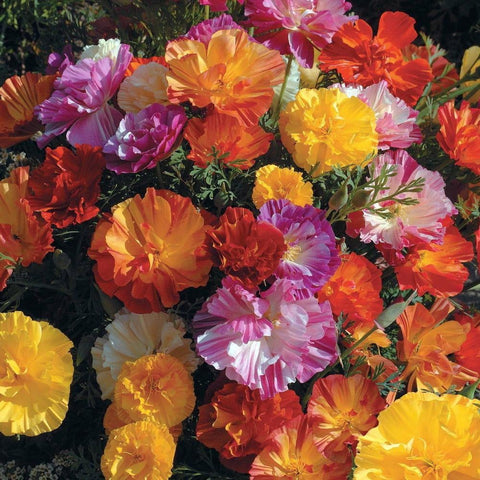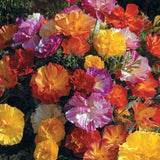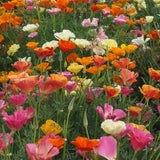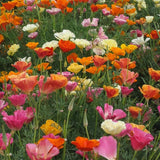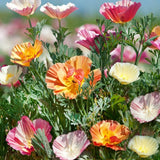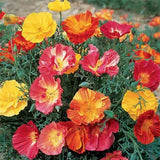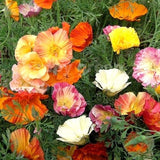(Eschscholzia Ballerina Double Mix)
Beautiful shades of red, pink, and gold will dazzle the eye with this popular Ballerina California Poppy mix. The silky, cup-shaped flowers form on slender stems just like the common Orange California Poppy, but this shows off with many more colors.Count: ~100 Seeds Open Pollinated, Non-GMO, neonicotinoid-free 100% Pure Seed, No Fillers Easy To Grow Bee Friendly Deer Resistant Pest / Disease Resistant Native Low Maintenance Good Rockgarden Or Alpine Plant Great For Mass Plantings Perennial is a warm region. Annual in cold regions. Zones: 3-10 Soil Type: Sandy Soil, Loamy Soil Bloom Time: Spring to Fall Ideal Region: Northeast, Southeast, Midwest, West, Southwest, Pacific Northwest Common Name: Ballerina California Poppy Botanical Name: Eschscholzia californica Annual / Perennial; Delicate petals and stunning blooms Double petals are textured; Plant en masse for a brilliant display Poppy seeds require a cool period to break dormancy, and some gardeners choose to cold stratify their seeds.These poppies have a habit of opening and closing with the sun, appropriate for their native Golden State. The first member of the California poppy genus was identified in 1816 by German botanist Adelbert von Chamisso on an exploratory voyage to California and the Pacific Northwest. Chamisso named this genus "Eschscholzia" after a fellow botanist, Johann Friedrich von Eschscholtz, who accompanied him on the journey. Nearly a dozen species of poppy grow wild in the western United States.If you love the bold, easy-to-grow blooms that California Poppies add to the summer meadow, this mixture is the perfect choice for you! Red, orange, and yellow blooms ignite the garden or meadow and make for fiery-cut bouquets. Splendid Mix is deer resistant, easy to grow and blooms for months. Growing to be only 12-18” tall, we recommend planting this mixture in the border of the meadow or garden. All of the seed we handle at American Meadows is non-GMO, neonicotinoid-free, and guaranteed to grow. Annual.This rainbow of all colors from a classic is just as easy to grow, and just as dependable for color as the solid orange blooms have always been. About California PoppiesThis famous flower, the state flower of California, (a very similar sub-species is called Mexican Gold Poppy) carpets whole coastal hillsides up and down the Pacific coast, creating one of the most famous natural wildflower displays in the world, usually in April. Viewing this spectacle from their ships, Spanish explorers thought the “golden display” meant that there was in fact, gold to be found in the flowery hills.The “Ballerina” California Poppy is an absolute beauty that is sure to add heaps of color - and intrigue - to your flower garden. This variety has double petals in a wide range of brilliant colors and is not your typical California Poppy. As with all Eschscholzia varietals, Ballerina tends to perform best when planted en masse. Plant directly in your garden, and it will spread easily! California poppy performs well almost everywhere with its dusty dark green ferny foliage and brilliant golden orange cup-shaped flowers. A blooming plant is somewhat frost-resistant and often reblooms nicely in fall meadows. Flowers close in cloudy weather. The name “Eschscholzia” is after the Russian botanist, J. F. Eschscholtz, who visited the California coast in the early 1800s.In a home garden setting, they are typically treated as an annual flowers, but California poppies are actually short-lived perennials where they are hardy. They will easily reseed in the garden for years to come.The Ballerina California Poppy is a real stunner that is sure to add heaps of color - and intrigue - to your flower garden. This variety has double petals in a wide range of brilliant colors and is not your typical California Poppy. As with all Eschscholzia varieties, Ballerina tends to perform best when planted en masse. Plant directly in your garden and it will spread easily!The ultimate self-seed ground cover annual that will grow almost anywhere producing a graceful mixture of colors across the spectrum – warm orange, to sulfur yellow, white, carmine rose, lilac and scarlet. In double to semi-double, crepe-like flowers reaching about 14 inches in height. A stunning mix for informal planting thriving on neglect and drier conditions. Blooms spring into summer, especially in cool weather. Great fillers in flower beds and containers.Cultivation Advice California Poppy Ballerina Mix ------------------------------------------------------------------- Plant seed directly outdoors early through mid-spring in a sunny location with well-drained soil. Cultivate soil, mix seeds with a cup of sand or soil, and broadcast lightly over the planting area. Lightly rake into soil or cover lightly to a depth of 1/8 inch. Can be sown in the autumn in mild winter areas (they will self-seed and survive the winter more than adequately by themselves). Keep soil moderately moist during germination. When plants are about 2 inches tall, thin 8 to 12 inches apart to get the best display. Poppies do not transplant well. Avoid over-watering once plants are established. Remove or cut off old flower bases for continued flowering throughout summer. Plants will self-sow if left to their own devices. California poppies thrive on a certain amount of neglect.GROWING INSTRUCTIONS:Sowing: Sow in early spring, planting the seed 1/4" below the surface of the soil; keep the soil lightly moist until germination, which should occur in 2-3 weeks at a soil temperature of 60-65 degrees. In USDA Zones 7 and warmer, this seed can be fall planted. Poppies do not transplant well and must be planted while very small if started indoors.Growing: Water seedlings occasionally, but decrease watering as the plants mature; poppies tolerate drought well and will only need watering in periods of extreme dryness. This plant tolerates most soils that drain well, as well as adapting to seaside conditions. This plant does not need rich soil and actually blooms best in poor soil. Pinch off faded blossoms for the most prolific blooming. These flowers prefer cool temperatures, usually blooming in spring and early summer and going dormant when the summer heat begins. Though an annual, it will reseed itself and return the following year. Poppies attract bees and butterflies.Harvesting: For the longest-lasting cut flowers, choose poppies that have just begun to open; cut them in the morning while the moisture is at its peak. Sear the cut ends of the flowers with boiling water or a match, and immediately plunge them into cold water. Place them in a vase with water at room temperature.Seed Saving: When saving poppy seeds, keep in mind that the resulting flowers sometimes revert to the dominant orange or red blossoms. After the petals drop off the flower, the capsule will begin to turn from green to light brown. As soon as the capsule opens at the top and the seed inside ripens to a grayish-black, cut off the heads and spread them out to dry for several days. Shake them to remove the seed. Store the seed in a cool, dry place.
Beautiful shades of red, pink, and gold will dazzle the eye with this popular Ballerina California Poppy mix. The silky, cup-shaped flowers form on slender stems just like the common Orange California Poppy, but this shows off with many more colors.Count: ~100 Seeds Open Pollinated, Non-GMO, neonicotinoid-free 100% Pure Seed, No Fillers Easy To Grow Bee Friendly Deer Resistant Pest / Disease Resistant Native Low Maintenance Good Rockgarden Or Alpine Plant Great For Mass Plantings Perennial is a warm region. Annual in cold regions. Zones: 3-10 Soil Type: Sandy Soil, Loamy Soil Bloom Time: Spring to Fall Ideal Region: Northeast, Southeast, Midwest, West, Southwest, Pacific Northwest Common Name: Ballerina California Poppy Botanical Name: Eschscholzia californica Annual / Perennial; Delicate petals and stunning blooms Double petals are textured; Plant en masse for a brilliant display Poppy seeds require a cool period to break dormancy, and some gardeners choose to cold stratify their seeds.These poppies have a habit of opening and closing with the sun, appropriate for their native Golden State. The first member of the California poppy genus was identified in 1816 by German botanist Adelbert von Chamisso on an exploratory voyage to California and the Pacific Northwest. Chamisso named this genus "Eschscholzia" after a fellow botanist, Johann Friedrich von Eschscholtz, who accompanied him on the journey. Nearly a dozen species of poppy grow wild in the western United States.If you love the bold, easy-to-grow blooms that California Poppies add to the summer meadow, this mixture is the perfect choice for you! Red, orange, and yellow blooms ignite the garden or meadow and make for fiery-cut bouquets. Splendid Mix is deer resistant, easy to grow and blooms for months. Growing to be only 12-18” tall, we recommend planting this mixture in the border of the meadow or garden. All of the seed we handle at American Meadows is non-GMO, neonicotinoid-free, and guaranteed to grow. Annual.This rainbow of all colors from a classic is just as easy to grow, and just as dependable for color as the solid orange blooms have always been. About California PoppiesThis famous flower, the state flower of California, (a very similar sub-species is called Mexican Gold Poppy) carpets whole coastal hillsides up and down the Pacific coast, creating one of the most famous natural wildflower displays in the world, usually in April. Viewing this spectacle from their ships, Spanish explorers thought the “golden display” meant that there was in fact, gold to be found in the flowery hills.The “Ballerina” California Poppy is an absolute beauty that is sure to add heaps of color - and intrigue - to your flower garden. This variety has double petals in a wide range of brilliant colors and is not your typical California Poppy. As with all Eschscholzia varietals, Ballerina tends to perform best when planted en masse. Plant directly in your garden, and it will spread easily! California poppy performs well almost everywhere with its dusty dark green ferny foliage and brilliant golden orange cup-shaped flowers. A blooming plant is somewhat frost-resistant and often reblooms nicely in fall meadows. Flowers close in cloudy weather. The name “Eschscholzia” is after the Russian botanist, J. F. Eschscholtz, who visited the California coast in the early 1800s.In a home garden setting, they are typically treated as an annual flowers, but California poppies are actually short-lived perennials where they are hardy. They will easily reseed in the garden for years to come.The Ballerina California Poppy is a real stunner that is sure to add heaps of color - and intrigue - to your flower garden. This variety has double petals in a wide range of brilliant colors and is not your typical California Poppy. As with all Eschscholzia varieties, Ballerina tends to perform best when planted en masse. Plant directly in your garden and it will spread easily!The ultimate self-seed ground cover annual that will grow almost anywhere producing a graceful mixture of colors across the spectrum – warm orange, to sulfur yellow, white, carmine rose, lilac and scarlet. In double to semi-double, crepe-like flowers reaching about 14 inches in height. A stunning mix for informal planting thriving on neglect and drier conditions. Blooms spring into summer, especially in cool weather. Great fillers in flower beds and containers.Cultivation Advice California Poppy Ballerina Mix ------------------------------------------------------------------- Plant seed directly outdoors early through mid-spring in a sunny location with well-drained soil. Cultivate soil, mix seeds with a cup of sand or soil, and broadcast lightly over the planting area. Lightly rake into soil or cover lightly to a depth of 1/8 inch. Can be sown in the autumn in mild winter areas (they will self-seed and survive the winter more than adequately by themselves). Keep soil moderately moist during germination. When plants are about 2 inches tall, thin 8 to 12 inches apart to get the best display. Poppies do not transplant well. Avoid over-watering once plants are established. Remove or cut off old flower bases for continued flowering throughout summer. Plants will self-sow if left to their own devices. California poppies thrive on a certain amount of neglect.GROWING INSTRUCTIONS:Sowing: Sow in early spring, planting the seed 1/4" below the surface of the soil; keep the soil lightly moist until germination, which should occur in 2-3 weeks at a soil temperature of 60-65 degrees. In USDA Zones 7 and warmer, this seed can be fall planted. Poppies do not transplant well and must be planted while very small if started indoors.Growing: Water seedlings occasionally, but decrease watering as the plants mature; poppies tolerate drought well and will only need watering in periods of extreme dryness. This plant tolerates most soils that drain well, as well as adapting to seaside conditions. This plant does not need rich soil and actually blooms best in poor soil. Pinch off faded blossoms for the most prolific blooming. These flowers prefer cool temperatures, usually blooming in spring and early summer and going dormant when the summer heat begins. Though an annual, it will reseed itself and return the following year. Poppies attract bees and butterflies.Harvesting: For the longest-lasting cut flowers, choose poppies that have just begun to open; cut them in the morning while the moisture is at its peak. Sear the cut ends of the flowers with boiling water or a match, and immediately plunge them into cold water. Place them in a vase with water at room temperature.Seed Saving: When saving poppy seeds, keep in mind that the resulting flowers sometimes revert to the dominant orange or red blossoms. After the petals drop off the flower, the capsule will begin to turn from green to light brown. As soon as the capsule opens at the top and the seed inside ripens to a grayish-black, cut off the heads and spread them out to dry for several days. Shake them to remove the seed. Store the seed in a cool, dry place.

